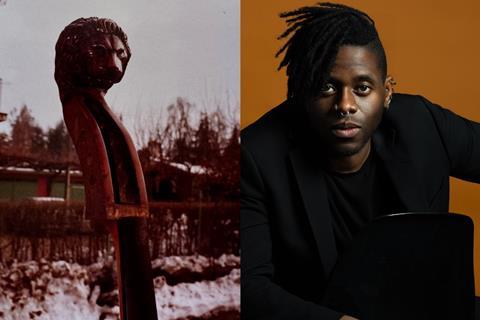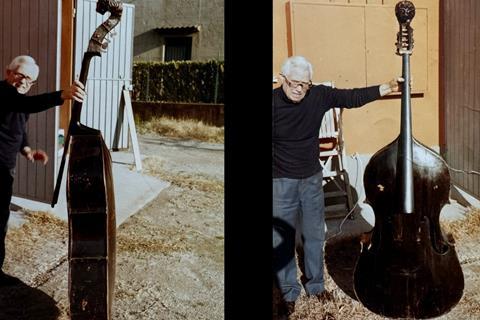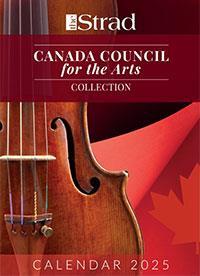A surgeon at Mount Sinai Hospital and former Juilliard student, Dr Jess Ting has loaned the bass attributed to Luigi Alosio Marconcini to Charles

Read more lutherie articles here
A pioneer of gender-affirming surgery at Mount Sinai hospital in New York City has loaned a rare late-18th-century double bass attributed to Luigi Alosio Marconcini to double bassist and composer Kebra-Seyoun Charles.
Jess Ting, MD, is a graduate from the Juilliard School, where he studied music before switching careers to medicine. He is now assistant professor of surgery at the Mount Sinai Health System and led Mount Sinai’s first surgical genital reassignment surgery for the transgender population in 2016.
Ting heard that Charles was without a double bass to play. ’When I heard about Keb’s situation, it struck a chord with me. I was more than happy to lend them this beautiful instrument.’
’Having met Irene Miller, a collector and lender of rare violins, sometime earlier through the American Composers Orchestra (ACO)’s board chair, Sameera Troesch, Melissa Ngan, CEO of ACO reached out to her to seek help to find Kebra an instrument.
’Irene contacted Nicholas King, the founder of After Arts, who then contacted Dr. Jess Ting. Irene, Nick and Jess are all members of After Arts, a community of business professionals who share a background in music. The rest is history.’
Ting drew from his own experiences of not having an instrument that he could be proud of during his youth. He had formerly played on a double bass, which he described as ‘broken and decrepit’ at the time, during high school and his Juilliard studies. He taught himself to restore the instrument at the age of 15, describing it as ’a Frankenstein of an instrument,’ that lacked varnish and had a missing scroll volute.
’While it sounded great, its ridiculous appearance made it hard for others to take me seriously. The absence of a decent instrument was one of the reasons I eventually gave up pursuing a career in music.’
By gifting the 18th-century double bass to Charles, the winner of the 2022 Sphinx Competition senior division, Ting believes ’it feels like I’m lending a younger version of myself an instrument, compensating for the deprivations of my own youth.’
In addition, Ting provided funds for the commission of Charles’s new work for bass and orchestra, Nightlife concerto, via the American Composers Orchestra. The work will be premiered on 30 October at Zankel Hall, Carnegie Hall in New York City.
’Being able to provide the commission for the bass concerto on top of that? That’s just the icing on the cake!’ said Ting.
The late 18th-century double bass is attributed to Luigi Alosio Marconcini, who worked in Bologna, Ferrara and Venice and was a pupil of Omobono Stradivari. An unusual quirk of the instrument is its carved lion head and diminuitive size. Because of its short string length, Ting describes it as a niche instrument that is best suited to the soloistic playing style of Charles.

Ting has managed to piece together the instrument’s history via clues and fragments of its story and old photos. The instrument was discovered in a convent in Bologna in the early 1980s, then allegedly restored in Rastignano, Italy, in 1984, where it was completely revarnished by a luthier called Perritti.


It had reportedly been used for church services for a generation, before being put in storage for decades until it was rediscovered.
’I have a mental image of a janitor finding it in the back of a closet in the convent covered in inches of dust,’ said Ting.
The bass had lain unused for almost 40 years until Ting discovered it at an auction in England in 2022, after which he sent it back to the US.
’I had it brought back to playing condition and it has been sitting waiting for right person to play it until now.’
Ting has previously lent instruments to students in need for concerts and auditions, including to high school pupils of the New York String Ensemble, as well as a c.1600 Paolo Maggini bass to emerging double bass player Lizzie Burns.
Other basses Ting owns include a late-1700s Lorenzo Ventapane, Venice, c.1700s Testore (ex-David Walter), a c.1850 anonymous Venetian instrument, plus a c.1802 Abraham Prescott, New Hampshire.
Read: How I found my violin (or rather, how my violin found me) - Lois de Cruz
Read: Bass instinct: a new generation of double bass players
An exclusive range of instrument making posters, books, calendars and information products published by and directly for sale from The Strad.
The Strad’s exclusive instrument posters, most with actual-size photos depicting every nuance of the instrument. Our posters are used by luthiers across the world as models for their own instruments, thanks to the detailed outlines and measurements on the back.
The number one source for a range of books covering making and stringed instruments with commentaries from today’s top instrument experts.
The Canada Council of the Arts’ Musical Instrument Bank is 40 years old in 2025. This year’s calendar celebrates some its treasures, including four instruments by Antonio Stradivari and priceless works by Montagnana, Gagliano, Pressenda and David Tecchler.












































No comments yet